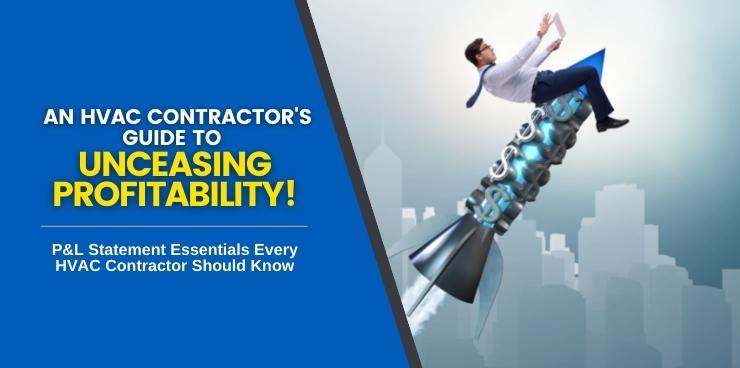As an HVAC contractor, ever wonder what a P&L statement is really telling you? You’re not alone. In fact, many small business owners are uncomfortable with this financial statement.
A P&L statement is also known as an income statement. It is a key financial document that shows your business’s revenue, expenses, and profit over a period of time. There is a lot of nuance to a P&L statement. Use your P&L to track the following:
- Your topline revenue
- Your gross profit
- Your net EBITDA
- Your actual KPIs against industry benchmarks
If you’re not an accounting major, you may find interpreting a P&L statement daunting at first. However, it’s actually quite straightforward. In this article, we’ll dissect what an income statement is and learn the essentials that HVAC contractors should know.
What is the Concept of Profit and Loss (P&L)?
The Profit and Loss Statement is one of the three financial statements used in gauging a business’s financial performance. The other two financial statements are the balance sheet and cash flow statement.
The P&L statement comes in a variety of other names:
- Income statement
- Statement of profit and loss
- Statement of operations
- Statement of financial results or income
- Earnings statement
- Expense statement
Like the other financial statements, the income statement is also submitted to the Securities and Exchange Commission (SEC) for filing if you’re a public company, and to your Private Equity partners if you sell the business in part or full. This document primarily focuses on 4 key elements:
- Revenue
- Expenses
- Gains
- Losses
Some HVAC Contractors I talk to about income statements have a common question.
What’s the difference between the cash flow statement and the P&L statement?
Both documents present essential information to describe the health and performance of a business. The cash flow statement is used to track the actual cash on hand from day to day. On the other hand, the P&L statement outlines the revenue, expenses, gains and losses over a given period.
While a cash flow statement can help you ensure you have enough to cover payroll on Friday, an P&L statement can tell you if you are over or underspending to generate your desired revenue.
Most business owners are very tuned into their P&L statement, particularly their net EBITDA, but very few are as cognizant of their daily and weekly cash flow.
It’s important to note that a P&L statement reveals the key aspects of a company’s financial reputation. Each one of the financial statements tells a distinct story of a business’s financials. However, it’s important to build and learn all the financial statements to uncover how each one complements the other. This will provide you with a comprehensive overview of your financial health, performance and standing versus other businesses.
For an HVAC business, understanding the P&L statement is critical to making informed decisions about pricing, services, and profitability. P&L statements help you identify areas of your business that are costing you money and where you may be able to save.
If you need help interpreting your P&L statement for your residential home service business, Wizard of Sales® is the one to call. Book a demo.
The 2 Accounting Methods of P&L Statements
As a residential home service business owner, understanding how P&L statements work is only one piece of a bigger picture. You must also know the accounting methods you can implement when working on your company’s P&L statement.
There are two methods of accounting used to calculate a P&L statement:
- Cash basis
- Accrual basis
Businesses are allowed to choose either method when accounting the revenue and expenses. However, per the IRS, businesses earning beyond $25 million in their annual gross receipts must use the accrual method. Moreover, corporations are prohibited from using the cash accounting method according to the USA Tax Reform Act of 1986.
It’s important to know the two accounting methods because each one uses different timing when recording income and expenses. This is especially relevant in the HVAC service or any other residential home service industry businesses. We’ll learn how below:
Cash Method
The cash method is also known as cash-basis accounting. This is often described as the more straightforward but less accurate accounting method because:
- Payment receipts are only recorded during the time they are received.
- Expenses are only recorded at the moment when they are paid.
In other words, the actual receipt of payment is required when recording revenues. Also, you only record the payment only after the expenses are paid. In contrast, accrual accounting records income when revenue is earned, regardless of whether cash is on hand. The accrual method recognizes expenses even if the bills have not yet been paid.
For example, you provided and completed a maintenance service for a client on March 10. If you didn’t receive the payment until April 5, you wouldn’t include the revenue in the Q1 P&L statement using the cash method. This creates problems for HVAC contractors that offer a pay-later option to their clients (a terrible idea, BTW). The fact that the closing of the project occurred a month before is irrelevant.
In the cash-basis method, you only record revenues when the payment is physically received.
Accrual Method
Accrual accounting, on the other hand, addresses the limitations of cash-basis accounting. This accounting style allows companies to record revenue before payments for services are received. Moreover, it records expenses as incurred, even if it’s before the company pays for them.
In other words, the accounting ‘books’ recognize the revenue earned whether or not the actual cash transactions are carried out. This method converges present inflows and outflows with projected cash inflows and outflows. Provide a more precise description of a business’s financial position in the P&L statement.
For example, suppose an HVAC contractor has a customer use their third-party financing. The contractor can go ahead and do the work at the customer’s home and close the job. A few days later, they will collect the payment from the finance company for the sum total (less fees) for the job that is already tagged as closed and collected.
This is contrary to cash-basis accounting, which records revenue once the actual money is received. For this reason, the accrual method provides better insight into a business’s financial standing. I recommend all HVAC contractors use the accrual method when choosing their P&L statement.
Essential Things Every HVAC Contractor Should Know About a P&L Statement
At first glance, a P&L statement may look daunting. If it’s any consolation, Venetian Monks from the Middle Ages use income statements too. Luca Pacioli, a Venetian Monk dubbed, ‘The Father of Accounting’, introduced the accounting principles used in today’s income statements. For a seasoned HVAC Contractor like you, learning income statements will be easy peasy.
In this section, we’ll uncover what goes on an income statement. Plus, learn what and how HVAC contractors should do with their P&L statements. Keep reading.
Key Elements of P&L Statements
As an HVAC contractor, below are the key components you need to remember when creating P&L statements. The general rule of thumb is that your HVAC business should hold a 50% gross profit, 30% fixed expenses, and 20% net EBITDA.
You can’t beat an Income Statement with clever math. Keep your expenses in check and price your stuff right.
– Ryan Chute
For aggressively growing businesses and smaller companies, there, fixed expenses could stretch up to 40% until economies of scale are achieved. As successful companies achieve upward of $100 million in revenue, net EBITDA can commonly exceed 20% of topline revenue.
- Revenue
Revenues are the money you earn from normal company operations. This is also known as “sales” or “income”. Like expenses, revenue branchs into two categories: Operating and non-operating income.
Operating revenues are earned directly from the execution of business operations.
Non-operating revenue, on the other hand, is earnings from non-core operations. For example, interest from banks or dividends from the company’s external investments.
- Gross Profit
Gross profit is also called, “gross income” or, “gross margin”. This is the profit left over after covering the variable costs of selling your goods and services, also know as operating profit. Gross profit is calculated through this equation:
Gross Profit = Total Revenue – Cost of Goods Sold (COGS)
For an HVAC business, your gross profit is what you will use to cover your fixed expenses. If you have a 50% gross profit, your fixed expenses need to be less than 50% to realize a net profit. Anything more than 50% fixed operating expenses and you are losing money, in this example.
- Fixed Expenses
These are the (predominantly) static operating costs of running your business. They can either be primary or secondary expenses. For example, a primary expense would be the cost associated with your business’s primary operations like payroll, trucks, advertising, and software subscriptions.
Secondary expenses are linked to non-primary business operations. This includes the office supplies like coffee and paperclips, for instance.
- Net Profit
Net profit (or net EBITDA) Is the precise measure of a company’s profitability. It is the remaining profit when all the underlying expenses and costs have been deducted from the total revenue. Net EBITDA is computed by this equation:
Net Profit = Total Revenue – (COGS + Operating Expenses)
Once you have net EBITDA, you can factor in other, non-operational income as well as interest, taxes, depreciation, and amortization to see what your bottom line is.
 Review your P&L Statements Monthly
Review your P&L Statements Monthly
A P&L statement is more than a document for compliance. It can be helpful for HVAC businesses to read and interpret income statements regularly. Take 1 hour every month to review your income statement. Doing so will help you:
- Understand how your business is performing against industry benchmarks and prior years.
- Find and correct errors like putting expenses in the wrong spots.
- Develop strategies for scaling your business profitably.
- Stay on top of gains to maximize your shareholder equity.
Build a Strategic Plan Based on Your P&L Statements
An HVAC contractor should take advantage of the information in P&L statements along with the other two important financial statements. This will help business owners strategize, budget, and forecast. For instance, if you may decide to work with an advertising agency to double your conversions and 10X your club memberships. You can also use this information to plan capacity and shoulder seasons.
Understanding your P&L Statements is Critical to Your Success
A P&L statement can do wonders when planning to scale your business quickly and profitably. By eliminating errors and drawbacks that limit your HVAC business’s growth, you can double down on revenue generating activites. This is the secret sauce to your success.
If this is the goal for your HVAC company, it begins with an intentional focus on your P&L statement.
What help driving revenue and profits? Wizard of Sales® can help. Book a call.



 Review your P&L Statements Monthly
Review your P&L Statements Monthly